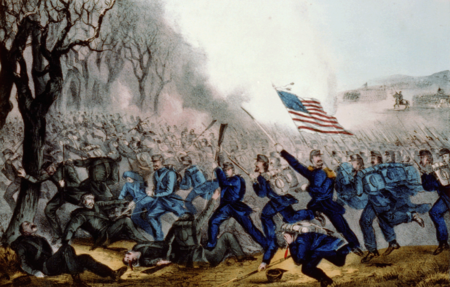The overall Confederate commander in the West was General Albert Sidney Johnston. His troops were placed along a wide defensive line, and they were not strong at any point. The commander in East Kentucky was General George Crittenden with 4,000 men. Union General George Thomas, a Virginian who had remained with the Union, was sent with almost 6000 men to drive Crittenden across the Cumberland River. One of Crittenden's subordinates, Brigadier General Zollicoffer had placed his troops on the northern bank of the river to be closer to the Federals, even though the southern bank was a much better defensive position. Crittenden decided to launch a night attack against the advancing Thomas to enable him to pull back to safety.
 |
| First phase of the battle |
When they reached the Union forces at dawn on January 19th, the Confederates were cold, tired, and way behind schedule. Many carried flintlocks, which were useless because of the rain. However, they launched a heavy attack and at first drove back the Union forces. General Zollicoffer was killed by the Union troops when he got confused in the fighting and thought they were his men. Crittenden was able to rally his men and lead them forward, but they were struck on the left flank by arriving Union forces. The Southerners were driven into a rout, and they lost 12 cannon, 150 wagons and 1000 animals. Lt. Col. Kise of the 10th Indiana wrote this in his report:
The whole regiment, from right to left, was now warmly engaged, and slowly but surely driving the enemy before them, when I ordered a “charge bayonet,” which was promptly executed along the whole line. We soon drove the enemy from his place of concealment in the woods into an open field 200 yards from where I ordered the charge. When we arrived at the fence in our front many of the enemy were fo und lingering in the corners, and were bayoneted by my men between the rails. I pressed onward, and soon beheld with satisfaction that the enemy were moving in retreat across the field, but I suddenly saw them halt in the southeast corner of the field on a piece of high ground, where they received considerable re-enforcements and made a last and desperate effort to repulse our troops. In the mean time the gallant Colonel McCook, with his invincible Ninth Ohio Regiment, came in to our support, and for twenty or thirty minutes a terrific struggle ensued between the two opposing forces. I never in all my military career saw a harder fight. Finally the enemy began to waver and give back before the shower of lead and glittering steel brought to bear on his shattered ranks, and he commenced a precipitate retreat under a storm of bullets from our advancing forces until his retreat became a perfect rout.
Although this was the second largest battle in Kentucky during the war, the casualties were pretty light. The North lost 40 killed and 200 wounded, the South 125 killed and 400 wounded. Crittenden was removed from command on charges of drunkenness. This was a common accusation for unsuccessful generals during the Civil War, and we will certainly hear of it again.
 |
| Second phase of the battle |





0 comments:
Post a Comment